- The History of the Osaka Municipal Wholesale Markets -
The market, which handles the buying and selling of vegetables, fruit, fish and other fresh food stuffs meeting the daily needs of Osaka residents, was originally begun around the time that Osaka Castle was built.
As the population increased markedly at the beginning of the Edo period, the city began to prosper and markets were started near important waterways and roads. These markets were heartily welcomed by the ordinary people and became a standard part of their daily lives. Several of these markets carried on a lively business up until the beginning of the Showa period. The famous markets of that era were the Tenma, Zakoba, Utsubo, Kizu and Nanba markets.
The `Rice Rebellion` of 1918 led to the standardization of trading practices and price regulation which brought stability to the markets. As the need for the more stable distribution of fresh produce increased, the Central Wholesale Market Law was enacted in 1923. After that, research was done in Osaka to help determine the best place to open a central wholesale market. As a result of that research, a government license was issued in March 1925 and the existing wholesale markets were combined into the central market. In November 1931, the Osaka Municipal Central Wholesale Market was opened at the very accessible location of Noda in the Fukushima Ward. During the World War II, the market was temporarily closed due to rationing. However, the wholesale system was resumed in 1950.
In November 1964, in order to keep pace with the increase in demand resulting from Japan's rapid economic growth, a new market was opened in the Imabayashi of Higashi Sumiyoshi Ward. It is known as the East Wholesale Market, and together with the Central Wholesale Market, it has played a major role in helping to provide perishables to the residents of Osaka.
In addition to the pershable foods markets, Meat Wholesale Market was established in Tsumori of the Nishinari Ward in 1958 along with the municipal slaughter house. It was the first of it's kind nation-wide.
In recent years the massive changes which have occurred in the distribution market have had a major impact on all of the markets. In order to adapt to the changing marketing environment, the west wing of the Central Wholesale Market which deals in fruit and processed foods was remodeled during the fiscal years 1972 through 1976. Processed foods shops and intermediate wholesaler's wing of the East Wholesale Market were remodeled during the fiscal years 1976 through 1980.
In April 1984, the meat wholesale market was moved to the South Port (Nanko) area of the Suminoe Ward and reopened as the `South Port Wholesale Market`. The new market is equipped with completely modern facilities to insure the sanitary processing of fresh meat. In addition to those changes a major remodeling of the Central Market's facilities were began in February 1990 and complated in November 2002. Market facilities have been improved and a modern information system was set-up, which will help the market continue the distribution of fresh foods well into the 21st century.
- What is the Central Wholesale Market ? -
The Central Wholesale Market plays an irreplaceable part of our daily lives. It is the place which provides us with the fresh vegetables, fruit, marine produce and fresh meat which we need every day. The Market shoulders the crucial functions of bringing in produce from the various producers, setting the fair price, and providing the stable distribution of fresh produce for the consumers.
Fresh produce by it's very nature has a short life span. It is also easily affected by changes in weather and other natural factors leading to unpredictable production levels and changes in the balance between supply and demand. That in turn greatly affects the price.
In light of these factors, the Wholesale Market strives to carry on the job of gathering, pricing and distributing large quantities of fresh produce in as effective a way as possible to help insure the variety and safety of the produce which consumers need. And in so doing, add stability to the dietary habits of the residents of Osaka.
For these reasons, the local government, under the approval the Minister of Agriculture, Forestry and Fisheries in accordance with the Wholesale Market Law, has opened, maintained and operated the Central Wholesale Market.
- The Various Functions Of the Central Wholesale Market -
The Wholesale Market Carries out Five Important Functions:
| Collection A wide range and rich variety of goods are gathered. |
|
| Fair Pricing
A fair price is determined via auction which accurately reflects the current environment of supply and demand. |
|
| Commodity Distribution
Goods are expediently distributed to a large number of retailers. |
|
| Sound Settlement Accounts Payment of charges is made quickly and properly under the fixed rules. |
|
| Providing Information The collection and distribution of information relating to current supply and demand. |
- People who work at the Central Wholesale Market -
 |
Wholesalers These are the people who sell the goods that producers have consigned to them. After prices have been determined auction and bidding process, they sell to the intermediate wholesalers and participant buyers. Wholesalers are required to have obtained permission from the Minister of Agriculture, Forestry and Fisheries. |
 |
Intermediate Wholesalers These are the people who purchase fresh produce in bulk quantities from the wholesalers and then divide it into appropriate quantities in order to sell to retailers and others wanting to purchase goods. Intermediate wholesalers are required to get permission from the mayor. |
 |
Participants Buyers Those who don't own their shops in the wholesale market, but are allowed to purchase goods from wholesalers. They are required to have the approval from the mayor. |
 |
Related Traders These are all other traders which help the market function better and offer greater convenience to those who use the market. They are required to get permission from the mayor. |
 |
Osaka City (Establishment Authority) The city has been issued a permit from the Minister of Agriculture, Forestry and Fisheries and is responsible for the maintenance, and management of facilities, giving direction of sales and inspection of the market. |
- Flow of Food Distribution -
- Food Sanitation Inspection Laboratory / Osaka City Public Health and Welfare Bureau -
This department exists for the purpose of insuring the safety of the food products which are marketed locally and protecting the health of the residents of Osaka.
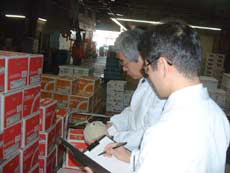 Inspections (Bacterial inspection and Physicochemical inspections)
Including the following:
Inspections (Bacterial inspection and Physicochemical inspections)
Including the following:
Inspecting for food poisoning and bacterial contamination,Inspecting standards of the ingredients of food products.
Inspecting for residual antibiotics and food additives.
Inspecting for environmental pollutants such as PCB, mercury and TBTO.
Inspecting for the presence of residual agricultural chemicals
On site food product inspection
Facility inspections, etc.
Monitoring and Direction (both early morning and regular)
Inspections are performed prior to auctions in addition to thorough inspections of the entire marketplace. Checks are made as to whether or not food stuffs are being handled properly.
The following areas are given particular attention.
Poisonous fish and shellfish are removed, The level of freshness is checked, Care is taken to confirm proper labeling, The condition and temperature of storage is checked, Checks are made as to insure sanitary handling of products, etc.
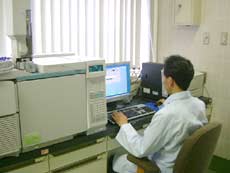 Sanitary Education
Sanitary Education
Those businesses which operate both within the market and outside it, together with other businessmen and city residents, are given instruction regarding sanitation in an effort to broaden enlightenment of the importance of sanitation.
Consultation
Advice is given with regards to facilities and equipment as well as business permits and licensing matters. In addition, counsel is given regarding parasites in the food products, dealing with complaints and labeling, etc.
The Office's goal is to eliminate faulty and illegal food products and raise the level of safety in the market in order to strengthen consumer confidence.
- Meat Inspection Center / Osaka City Public Health and Welfare Bureau -
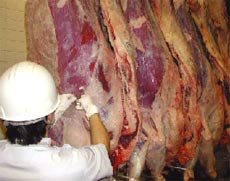 Slaughter House Inspections
Slaughter House Inspections
An individual inspection of all bovine and swine is carried out by veterinarians.
They do the following inspections:
Pre-slaughter , post mortem and BSE inspections (bovine)
Additional precise inspections are made on all bovine and swine which come into question as a result of the precursory slaughter house inspections.
All animals above-mentioned are tested for the presence of residual anti-biotics and medical supplies for animals.
Dressed carcass and internal organs are inspected for bacteria including E. coli O157.
Instruction is given to the workers at the slaughter house with regards to sanitation and on methods of improving the facility .
Only that meat which has passed the inspection and been proved to be safe is allowed to be shipped out of the South Port Wholesale Market.
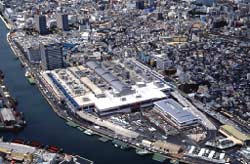 |
Central Wholesale Market 1-1-86, Noda, Fukushima-ku, Osaka 553-0005 Site area / 181,094m2 Building area / 317,046m2 Handling Items / Fruit and vegetables, Marine Product, Processed food |
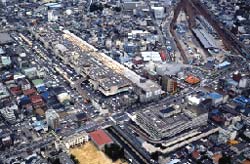 |
East Wholesale Market 1-2-68, Imabayashi, Higashisumiyoshi-ku, Osaka 546-0001 Site area / 105,615m2 Building area / 162,652m2 Handling Items / Fruit and vegetables, Marine Product, Processed food |
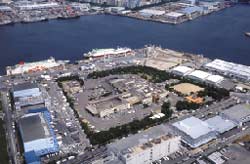 |
South Port Wholesale Market 5-2-48, Nanko-Minami, Suminoe-ku, Osaka 559-0032 Site area / 100,000m2 Building area / 32,171m2 Handling Items / Meat (except chicken) and its processed food |
- Access Map -

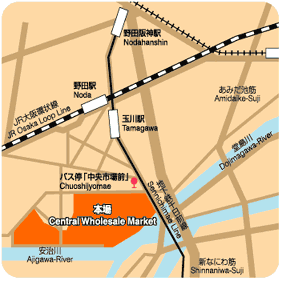 |
1-1-86, Noda, Fukushima-ku, Osaka 553-0005 TEL.06-6469-7955 FAX.06-6469-7979 |
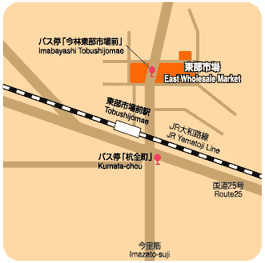 |
1-2-68, Imabayashi, Higashisumiyoshi-ku, Osaka 546-0001 TEL.06-6756-3901 FAX.06-6756-3905 |
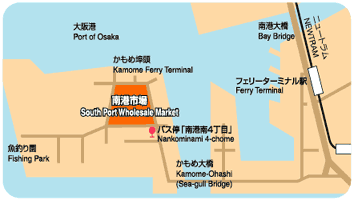 |
5-2-48, Nanko-Minami, Suminoe-ku, Osaka 559-0032 TEL.06-6675-2010 FAX.06-6675-2029 |


